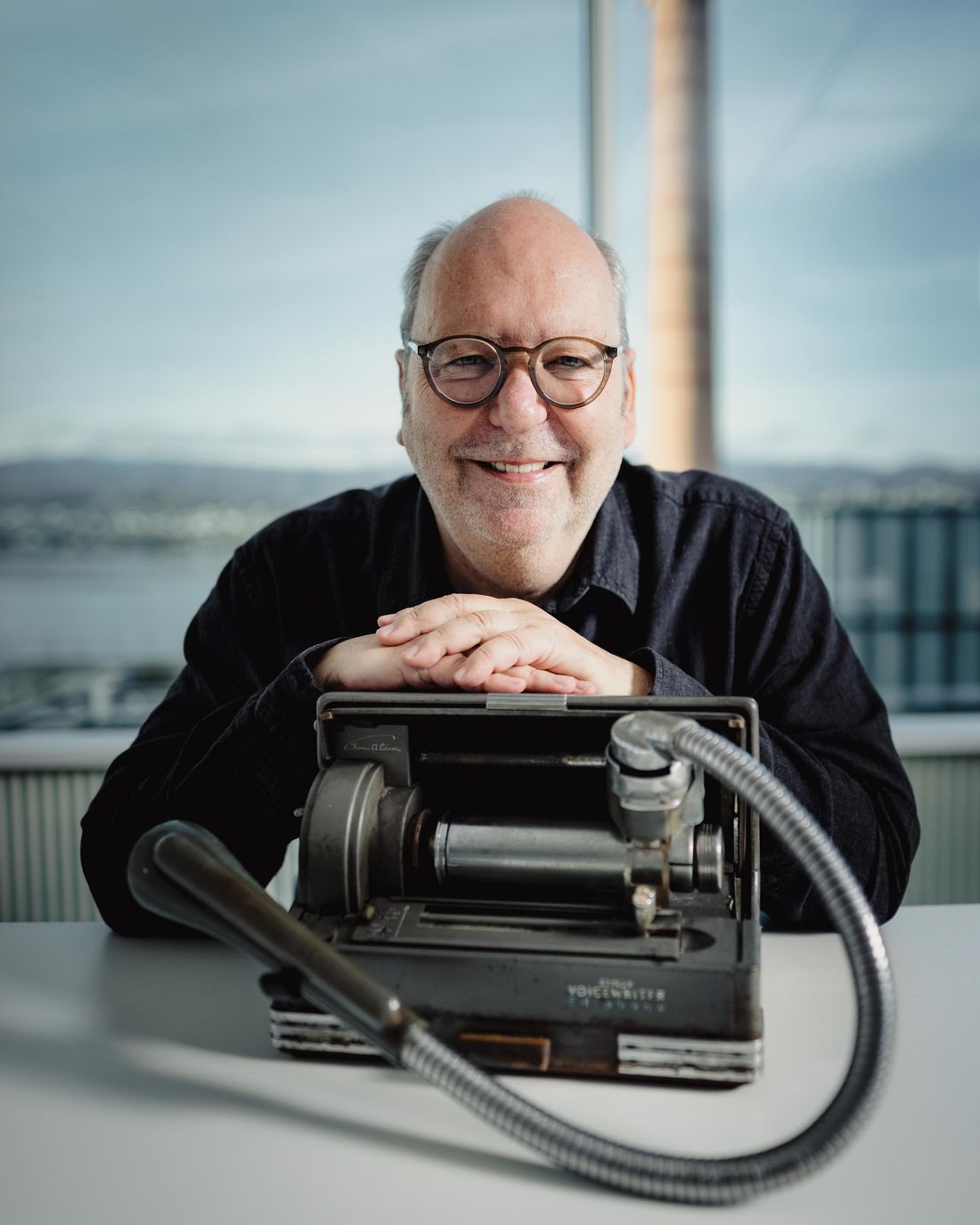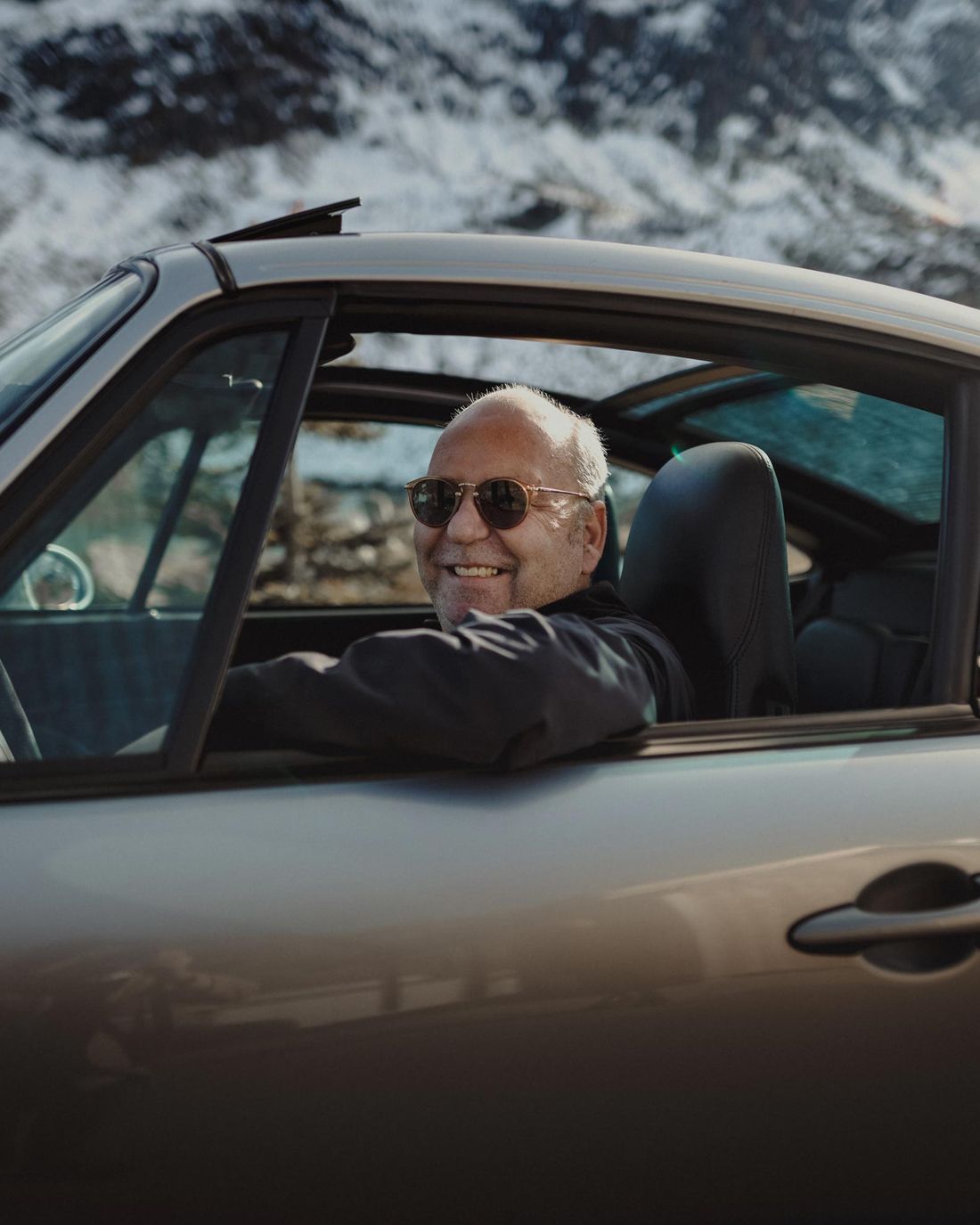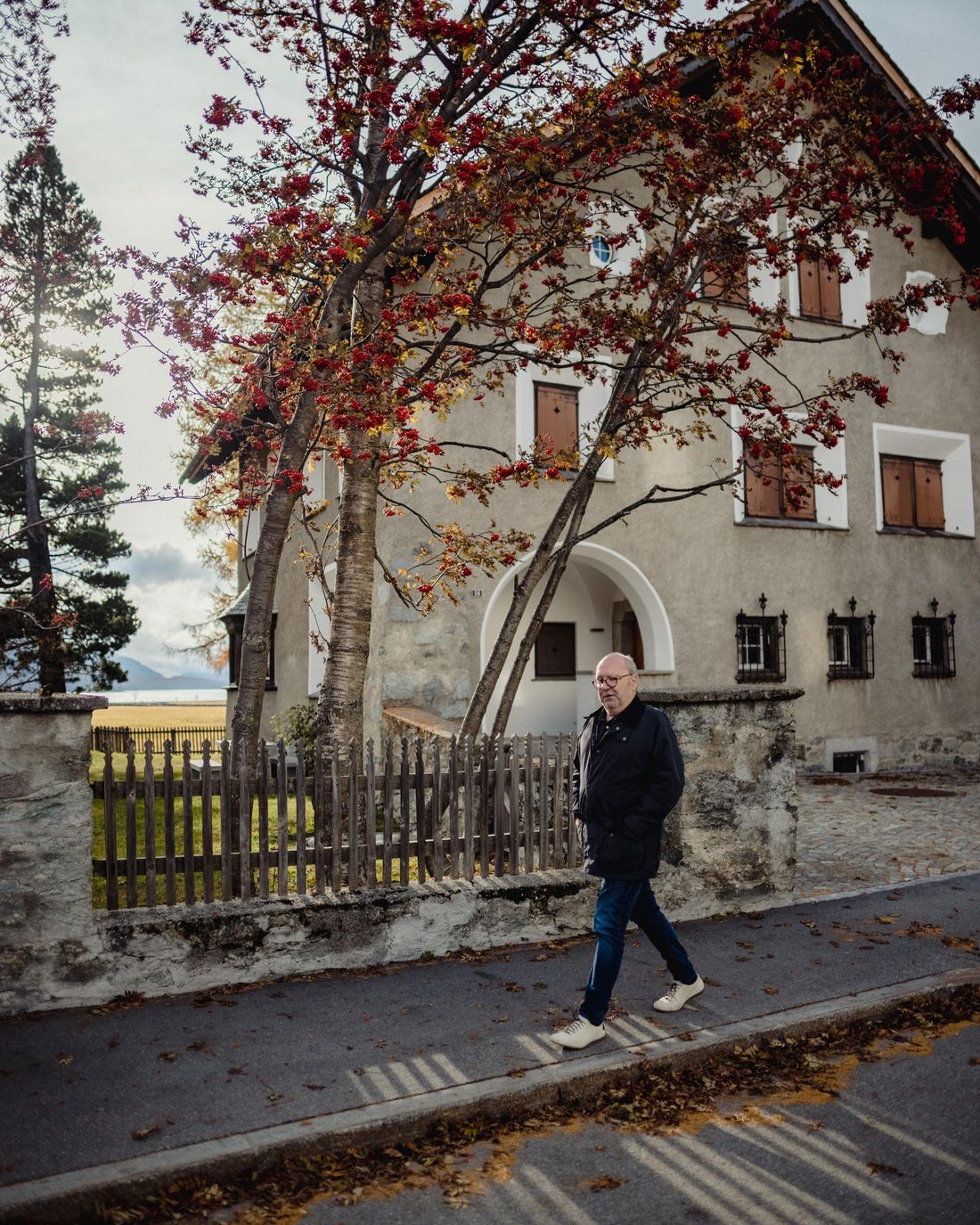
When the digital godfather speaks
Digital Picassos and the first internet experience accompanied by Israeli bodyguards – Martin Radelfinger’s life is more varied than some websites.
From analogue to digital
Bob Marley booms from the speakers of the classic Porsche 911 Targa as he drives over the Julier Pass and into the Engadine. The CD in the CD player in the boot has never been changed. Martin Radelfinger sits at the wheel and drives past a slightly snow-covered landscape and orange-glowing conifers. Whenever the wheels of the vintage car roll over a rough surface, the reggae musician begins to stutter. A rare example of how the analogue world shows the digital world its limits.
Martin goes to the high valley of Grisons every season of the year. The summer and winter seasons, which contrast greatly in the Engadine, are a true experience of nature. In winter, the valley and its frozen lakes become a vast white area that is surrounded by mountain ranges like a passe-partout. In summer, the dark blue of the lakes contrasts with the intensive green of the conifers. The furthest back spot in the Upper Engadine especially interests Martin.
Perhaps it is the continual transformation of the analogue as well as the digital world that so fascinates Martin that he has devoted his entire life to these two spheres.


The risk of a boreout
In his 20s in New York, Martin still received short messages on his pager – the triumph of the mobile phones had yet to transpire. In the heart of the metropolis, arranging a meeting was a challenge. Short notice cancellations did not exist. Then the mobile phone changed Martin’s world: The luxury of non-commitment had arrived. Nowadays it is more of a privilege to not own a mobile phone or to not always be reachable. But not for Martin: «Day or night, on holiday or on the weekend, I am happy to be reachable at all times and connected,» he confesses convincingly. And instead of hundreds of emails and missed calls lying in wait for him on Monday morning, he prefers to check for them continuously. When he is in the Engadine, having a business phone on Lake Sils is not an exception. Why not close a business deal in a beautiful setting?
Martin is not afraid of stress, but rather a boreout, which in Martin’s lexicon is an expression for boredom that ends in resignation. So, Martin enjoys constantly facing new challenges that, as regards innovation, are looking for people like him.


The digital revolution in his hand luggage
Flashback: The semester break was approaching. Martin, who was then working on a bachelor’s degree in Radio, Television and Film at the University of Texas at Austin, landed at the small airport in Bern in 1987. His hand luggage caught the eye of a vigilant Swiss customs officer. Between his toothbrush and clothing was something very unusual. After his third attempt to explain to the angry customs officer that it was a personal computer and that it was his work equipment, Martin gave up. The customs officer was certain thatMartin was trying to fool him. He did not stand a chance and had to pay the full import duty. That was not the only time: Martin had «interesting» conversations at Swiss customs when he visited Switzerland for Christmas as well.
In his younger years, Martin studied in America at the same time the Digital Revolution was marching forward with waving flags. He still enthuses about the communications department at the university: «It had a daily newspaper with a circulation of 54,000, two fully-equipped television studios and its own radio station. It was one of the first universities to have access to the internet, and it participated in
Apple’s pilot programme.» The father of a friend who had studied theology in Texas was the reason that Martin spent five years in the liberal part of Texas after training to be an optician. But eventually his time in warm Texas came to an end: In an academic delirium he chose Philadelphia for the ensuing master’s degree. His welcome gift was a cobblestone through the side window of his car and the theft of all of his valuables that had been inside. «Suddenly I was in the middle of a city that was ruled by a criminal mafioso,» says Martin reverently. Temple University in Philadelphia is located in the most rundown neighbourhood with burned-out houses. «Then I just had to visualise that I would live there for at least two years.» In the end, it was three more years. With time, Martin learned to appreciate the city’s special features. The open-air Italian market was his favourite place. In the cold season, fires burned in the many waste bins and provided Martin’s hands and the entire neighbourhood a bit of warmth.


Martin’s coup
Soon after receiving his master’s degree, Martin had his first internet experience: the development of a newspaper website in Honduras. Working for a consulting firm in New York, he accompanied newspaper publishers in Latin America during their digital transformation. The goal of his mission in Honduras: The diplomatic service should be able to read the national newspapers around the world via the internet. In Honduras, back then not even 10 per cent of the households had a telephone. The consulting proceeded in the style of a witness protection programme for a crown witness. Like in a film, Martin and his assistant landed in a helicopter on the roof of a newspaper company in Honduras or they rode in a black full-size SUV with tinted windows accompanied by armed Israeli bodyguards all the way to the entrance.
The job required working together with the national telecom company, Hondutel, which was run by the military. So, Martin was welcomed at the ministry in the capital by the officers responsible for Hondutel. They hardly understood anything about telecommunications, let alone the internet. Martin reported this to his employer when he gave his assessment. A few days later, the responsible soldiers were no longer responsible. The fact that upon Martin’s recommendation the responsible officers were discharged gave him and his assistant a rather queasy feeling. «We only travelled from the hotel to the newspaper and back again, always accompanied by our bodyguards.» Not until the aeroplane had taken off and begun to fly towards America did the two heave a sigh of relief.


WWW – When, how and why?
Coca-Cola wanted to run a national campaign in the more than 800 newspapers in the USA, but at the beginning of the 90s that was not so easy. There was no planning and booking system by which Coca-Cola could plan and book printed newspaper advertising nationally.
«New Media Development» was the name of the department at Editor & Publisher Company in New York where Martin worked a second job and where he had the goal of making the vision for a planning and booking system come true. He made use of the good example of one of the first online trading platforms, developed by former NASA employees in Houston, that made it possible to evaluate stocks with an analysis. But before one could access the World Wide Web via the now familiar internet browsers, one worked with a so-called BBS system (a bulletin board system). At the time, the internet was primarily used by the military and by academic institutions.
Martin and his team subsequently developed a programme that enabled agencies to nationally plan campaigns in newspapers via the internet on the basis of demographic and economic data. «The response was huge. The fact that theoretically one could now advertise nationally in over 100 print newspapers at the same time by means of a system excited everybody,» says Martin as he recalls the feedback from the many agencies and newspapers that he had visited during the two-year-long test phase throughout America.
In 1994 the big bang arrived: The internet went public and practically overnight Mosaic, Netscape’s browser, was launched. Suddenly internet content could be represented graphically, and the internet became the World Wide Web. This became possible due to an easy way to programme: With a few simple HTML codes, content could be rendered on the browser. That led to Martin and his team immediately burying their complex programme. A two-year-long development project had become obsolete overnight. In two months, the complex planning system became an easy-to-use website.


The advertising banner sees the light of day
«Hello world!» Suddenly all newspapers went online. For this, a new financing model had to be developed quickly. Martin, at the forefront, developed a (from the present perspective) simple programme at his own company. It analysed newspaper websites and searched for text paragraphs. When it found a particular one, a banner was placed there. After arousing the interest of the advertising agent Publicitas, Martin began to work in their multimedia development department, and from then on he was responsible for the transfer of technology from New York to Europe. That resulted in the development of a global marketer of internet advertising that had ambitions to go public but imploded during the internet bubble in 2000. After more than 20 years in the USA, Martin changed his place of residence and his place of work. He had received an offer from the Swiss advertising agency Wirz.
Transcoding analogue signals
Two events influenced the decision to return to Switzerland. Martin booked a direct flight from New York to Zurich for a meeting in Switzerland instead of flying via Geneva as usual. Shortly after landing he received a shock: The Swissair plane that headed towards Geneva on the same day crashed over Halifax. «My mother no longer expected me,» says Martin thoughtfully. During his stay in Switzerland, another event ran its course in New York: His apartment in Brooklyn burned down. Two signs that to Martin could not be clearer.
He moved into a small studio in the old town of Zurich with his wife and traded the turbulent party life of the metropolis of New York for a quiet daily life. «The illegal parties in industrial lofts that had a hint of Mad Men were now definitely a thing of the past,» says Martin with a grin.
The next major project was not long in coming: In June of 2000, Martin founded the Swiss subsidiary of the German online marketing company AdLINK Internet Media AG, which Tamedia AG joined. Martin’s experience in the American market earned him the exclusive marketing rights for the website of the then Tagesanzeiger AG as well as Mailservice GMX. Many Swiss have him to thank for their first e-mail address. The company quickly became the biggest online advertising marketer in Switzerland, and in 2004 it became part of Goldbach Media AG.


The magic word innovation
One recognises the needs, reveals inefficiencies and insufficient interconnections, and tries to address the problem with an appropriate idea, and usually with technology. That results in a solution that creates value.» That is Martin’s definition of innovation, his motivation. «The most beautiful moments are when one, through the process of innovation, can introduce something useful to the market,» he affirms.
Martin thinks that Switzerland is now an exciting platform that, above all in the development of new mobility, still has a lot of potential. «I would like to have the same feeling as in Singapore regarding urban planning,» says Martin, outlining his vision. A nationwide charging network that is stringently organised, and he has an electric car rental model in mind. Martin believes that individual mobility was adversely affected for a long time because developments progress so slowly here. Switzerland, with its numerous short-distance routes, seems predestined to play a leading role in the new mobility sector.
Does Martin feel there are also things that should remain the same? «There are a great many sectors in which innovation is not absolutely necessary. One reason why I like going to Tuscany is because Italian cuisine has tasted equally fantastic for hundreds of years.»
The digital Picassos
Martin collects them: communication devices of the past. For example, the 1927 Ediphone voice writer – a dictation machine that saves his information on a rotating wax disc. What fascinates him about the device is the analogue craftsmanship – the pure mechanics of it. «Thomas Edison focused on this device not least because he believed that the gramophone would never be able to reproduce music sufficiently well. But the dictaphone could functionally record and reproduce a voice. A wonderful example of how unforeseeable developments can be.»
In closing, he becomes philosophical: «There is art in the Digital Revolution too. The modern exhibits of the digital world are to be found nowadays in programming code or in a microchip with billions of circuits. Competitions in San Francisco that evaluate the visual aesthetics of the code are proof enough. Due to miniaturisation, these highly creative processes have withdrawn from our field of vision. Nowadays, however, everyone has a small work of art in their hand – in the form of a smartphone. So, the digital gains in importance only where people use it in the analogue world.»

